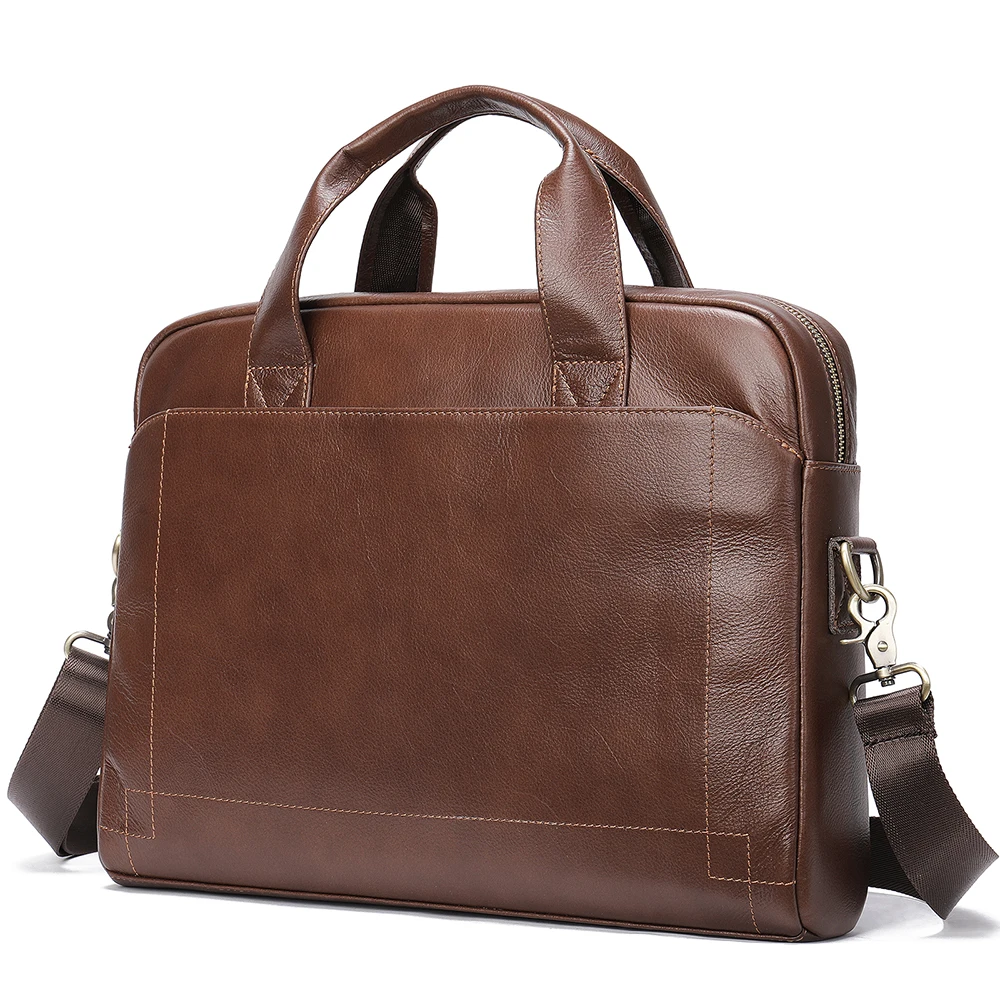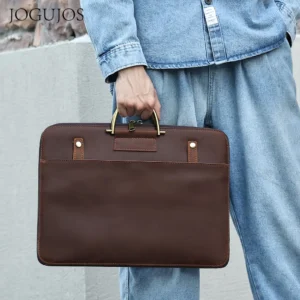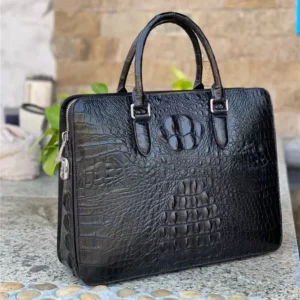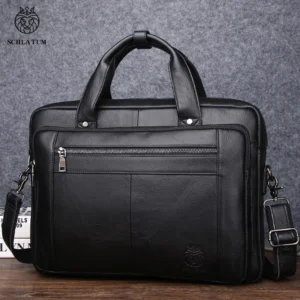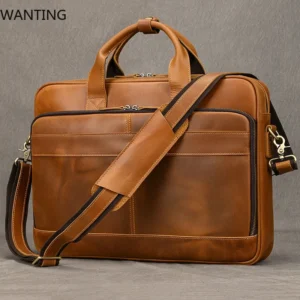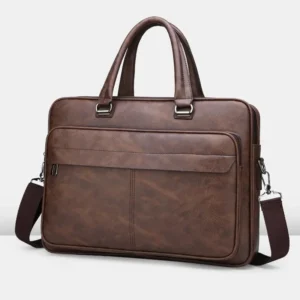The Enduring Appeal and Value of a Quality Leather Briefcase
In the world of professional accessories, few items make a statement as powerful as a well-crafted leather briefcase. More than just a container for your documents and devices, a quality leather briefcase serves as an extension of your professional image—a silent ambassador of your personal brand and attention to detail.
When you invest in a premium leather briefcase, you’re not just purchasing a bag; you’re acquiring a companion that will evolve alongside your career. Unlike disposable accessories that require frequent replacement, a superior leather briefcase:
- Develops a unique character and patina that reflects your professional journey
- Maintains functionality and structural integrity for decades with proper care
- Signals competence and attention to detail in professional settings
- Provides consistent performance as your most reliable daily companion
This comprehensive guide will walk you through the essential elements of selecting a briefcase that will serve you faithfully throughout your career. From understanding leather grades to evaluating construction techniques and matching styles to your professional needs, we’ll provide the knowledge needed to make an informed investment in your professional image.
The journey to finding your ideal leather companion starts with understanding what truly constitutes quality in the world of timeless classic leather briefcases. With numerous options available in our collection of classic leather briefcases, this guide will help you navigate the selection process with confidence.
Understanding Leather Quality: The Foundation of Your Investment
The foundation of any exceptional briefcase begins with the leather itself. Understanding leather grades is crucial—they’re not simply marketing terms but indicators of quality, durability, and value that directly impact your investment.
Leather Grade Hierarchy
| Leather Grade | Characteristics | Durability | Price Point | Patina Development |
|---|---|---|---|---|
| Full-grain | Natural surface texture, visible pores, strongest fibers | Excellent (20+ years) | Premium | Rich, distinctive |
| Top-grain | Sanded surface, thinner, more uniform appearance | Very good (10-15 years) | Mid-high | Good |
| Genuine leather | Split leather, often painted surface | Fair (3-5 years) | Budget-mid | Limited |
| Bonded leather | Reconstituted leather scraps | Poor (1-3 years) | Budget | None |
Full-grain leather represents the pinnacle of quality. Sourced from the top layer of the hide with its natural grain intact, this leather showcases the animal’s natural markings and texture variations. It contains the densest fiber structure, making it exceptionally durable and capable of developing a rich patina that tells the story of your professional journey.
Top-grain leather offers an excellent balance of quality and consistency. The surface is lightly sanded to remove imperfections, then finished with a light coating. While slightly less durable than full-grain, it maintains excellent strength while providing a more uniform appearance that many professionals prefer.
Genuine leather can be misleading. Despite its authentic-sounding name, it typically refers to split leather from lower layers of the hide, which lacks the natural strength of top layers. Often heavily processed with artificial finishes, it represents a significant drop in quality from full and top-grain options.
Bonded leather is the least desirable option, comprising leather scraps bonded together with adhesives and finished with a synthetic coating. Much like particleboard compared to solid wood, it lacks durability and will not develop the rich character that defines quality leather goods.
Tanning Processes and Their Impact
The tanning process significantly influences your briefcase’s characteristics and longevity:
- Vegetable tanning: Traditional method using plant-based tannins, creating firmer leather that develops exceptional patina but may be more susceptible to water damage
- Chrome tanning: Modern process using chromium salts, resulting in softer, more water-resistant leather that’s less likely to develop natural patina
- Combination tanning: Utilizes both methods for balanced properties
Authenticating Quality Leather
Quality leather has distinctive sensory characteristics. When evaluating a potential purchase:
- Visual inspection: Look for natural variations in grain pattern rather than perfectly uniform surface
- Touch test: Quality leather feels warm and develops a slight sheen where touched
- Aroma check: Natural leather has a distinctive, pleasant smell unlike the chemical odor of synthetic alternatives
- Edge examination: Cut edges of quality leather reveal fibrous layers rather than uniform, plastic-like material
Understanding these fundamental aspects of best leather briefcases provides essential knowledge for making an informed decision. The significant differences in leather vs. canvas bag durability highlight why premium leather remains the professional standard despite higher initial investment.
Construction Elements That Ensure Durability and Functionality
Beyond leather quality, the craftsmanship and construction techniques employed determine whether your briefcase will be a lasting professional companion or a short-term accessory. Understanding these elements allows you to evaluate potential purchases with a discerning eye.
Stitching: The Backbone of Durability
Quality stitching forms the literal backbone of your briefcase’s longevity:
- Stitch density: Smaller, tighter stitches (8-10 per inch) distribute stress more effectively than larger, sparse stitching
- Thread quality: Look for thick, waxed thread that resists moisture and abrasion
- Stitch pattern: Double or reinforced stitching at stress points such as handles, straps, and corners
- Consistency: Even, straight stitching without skips, puckers, or loose threads indicates attentive craftsmanship
When examining a briefcase, pay special attention to stress areas where handles attach to the body—these connection points endure daily lifting forces that test their structural integrity.
Hardware: The Functional Touchpoints
The hardware components represent both functional necessities and opportunities for quality distinction:
- Material superiority: Solid brass or stainless steel hardware offers superior durability and develops an appealing patina, unlike cheaper zinc alloys that may deteriorate or discolor
- Zipper quality: YKK or RiRi zippers provide smooth, reliable operation for years, while unbranded zippers frequently fail after limited use
- Buckle construction: Look for solid-piece construction rather than hollow or plated alternatives that may wear through
- Attachment methods: Hardware should be secured with reinforced stitching, rivets, or quality fasteners—not merely glued
Handle and Strap Construction
These critical contact points experience the most frequent stress:
- Reinforcement: Quality handles feature internal reinforcement such as steel cables or multiple leather layers
- Edge finishing: Properly burnished and sealed edges resist fraying and splitting
- Attachment method: Handles should be wrapped around internal supports and secured with multiple rows of stitching
- Comfort design: Subtle contouring that distributes weight comfortably across the hand
Pre-Purchase Inspection Checklist
When evaluating construction quality, use this practical checklist:
- Examine all stitching for evenness and reinforcement at stress points
- Test all hardware functionality multiple times
- Inspect interior lining for secure attachment and quality materials
- Check handle attachments for security and reinforcement
- Ensure edges are properly finished and sealed
- Verify zipper smoothness and alignment
- Assess overall symmetry and structural alignment
Thorough evaluation of these construction elements separates truly durable leather briefcase options from those that merely look impressive in the showroom. Understanding construction quality also helps in preventing scratches on leather briefcases through awareness of vulnerable points.
Briefcase Styles and Designs: Finding Your Perfect Match
The style of your briefcase should reflect both your professional environment and personal needs. Different designs offer varying degrees of formality, organization, and functionality that can significantly impact your daily experience.
Classic Styles and Their Professional Contexts
| Briefcase Style | Formality Level | Best For | Typical Features |
|---|---|---|---|
| Traditional Attaché | Highest | Legal, finance, executive roles | Hard-sided, structured, lock closure |
| Executive Briefcase | High | Management, client-facing roles | Semi-structured, multiple compartments |
| Portfolio/Folio | High | Creative professionals, minimal carry needs | Slim profile, document-focused |
| Messenger-style | Medium | Academic, tech, creative fields | Flap closure, casual versatility |
| Satchel | Medium-Low | Versatile use, business-casual environments | Softer structure, top handles with strap |
Traditional Attaché Case
The attaché case represents the most formal briefcase style, characterized by a hard-sided, box-like structure. These cases open like a suitcase, typically featuring:
- Rigid frame maintaining perfect structure regardless of contents
- Dual combination or key locks for security
- Limited expansion capacity but excellent document protection
- Strong association with legal, diplomatic, and executive professions
Executive Briefcase
The executive briefcase offers a more versatile approach while maintaining professional formality:
- Semi-structured design that holds shape but allows some flexibility
- Typically features top handles and sometimes a removable shoulder strap
- Multiple organized compartments for documents, technology, and accessories
- Often includes a dedicated laptop section and business card holders
- Suitable for most corporate environments and client meetings
Portfolio/Folio Cases
For minimalists or document-focused professionals:
- Ultra-slim profile with limited depth
- Often lacks handles, designed to be carried under the arm
- Primarily designed for documents, tablets, and minimal essentials
- Projects a sleek, focused professional image
- Ideal for presentations, interviews, and situations where mobility is prioritized
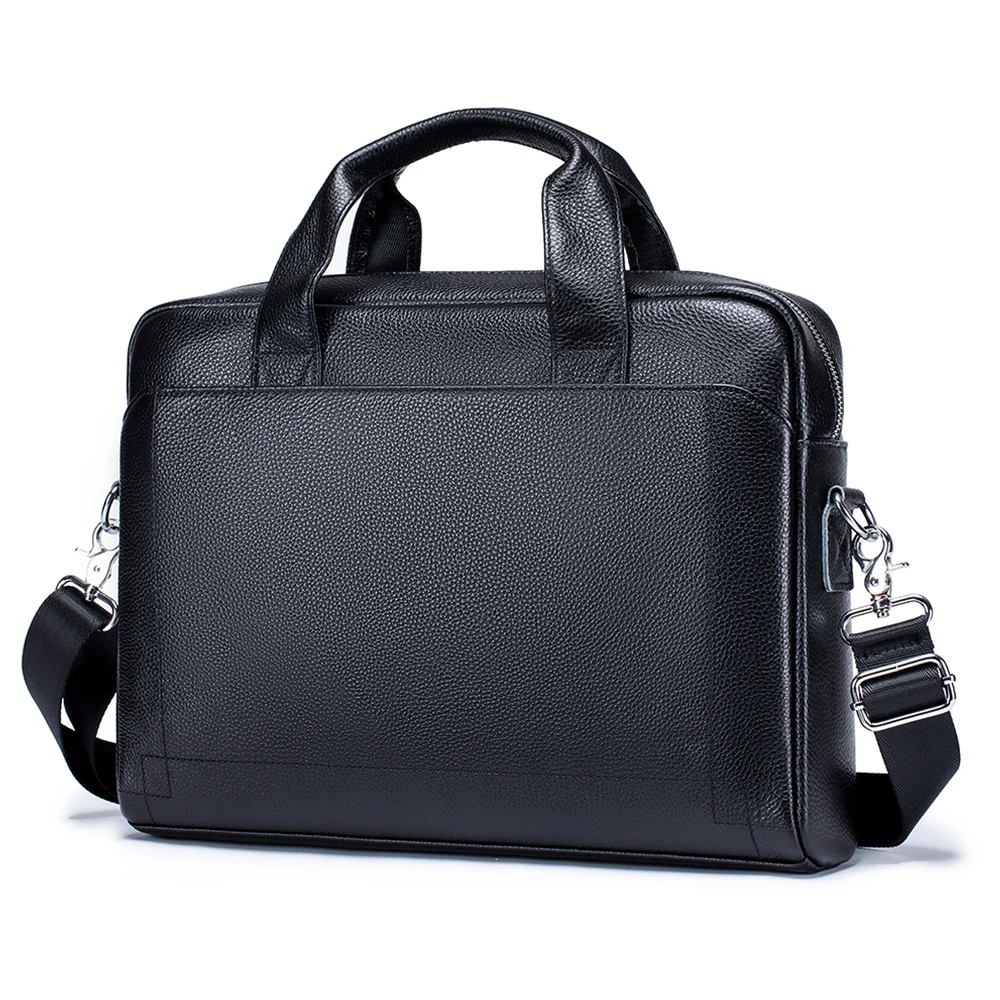
Messenger-Style Briefcases
Blending traditional and contemporary elements:
- Flap-over design with single shoulder strap
- More casual appearance suitable for creative and academic settings
- Typically offers excellent organization while maintaining accessibility
- Greater carrying capacity than traditional designs
- Often features quick-access external pockets
Satchel-Style Briefcases
These versatile options bridge formal and casual environments:
- Softer structure with both top handles and shoulder strap
- Doctor bag-inspired opening providing full access to contents
- Suitable for business-casual environments and varied professional contexts
- Adaptable to changing daily carry needs
Understanding these fundamental styles helps you align your selection with both professional expectations and personal preferences. Our definitive guide to classic leather briefcases provides deeper insights into traditional designs, while our collection of slim leather briefcases offers modern interpretations of timeless styles.
Functionality and Organization: Practical Considerations
The practical functionality of your briefcase directly impacts your daily efficiency and satisfaction. Even the most aesthetically pleasing briefcase will disappoint if it cannot accommodate your essential items or if its organization creates frustration rather than convenience.
Assessing Your Capacity Requirements
Begin your evaluation with a practical inventory of your daily essentials:
Essential Carry Assessment:
– Primary device(s): Laptop, tablet, or both (note specific dimensions)
– Paper documents: Folders, notebooks, planner (typical quantity and size)
– Small electronics: Phone, chargers, power bank, headphones
– Personal items: Wallet, keys, business cards, pens, eyeglasses
– Occasional items: Water bottle, small umbrella, light outerwear
– Industry-specific tools: Portfolio samples, specialized equipment
This inventory should inform both the external dimensions and internal organization required in your ideal briefcase.
Dimensional Considerations
When evaluating size:
– Laptop compatibility: Ensure dedicated laptop compartments accommodate your specific model with protective padding
– Document capacity: Standard briefcases should accommodate letter/A4 documents without folding
– Depth efficiency: Consider depth in relation to contents—too shallow restricts capacity while too deep creates disorganization
– Weight distribution: Wider designs distribute weight more effectively than tall, narrow profiles
– Proportional aesthetics: The briefcase should appear proportional to your physical frame
Organization Architecture
Effective internal organization balances separation and accessibility:
- Compartment design: Multiple separated sections prevent document crushing and item migration
- Accessibility hierarchy: Frequently used items should be accessible without rummaging
- Technology protection: Padded laptop/tablet compartments with secure closures
- Small item management: Dedicated spaces for business cards, pens, phones, and accessories
- Cable management: Consider solutions for chargers and electronic accessories
- Expandability: Some designs offer expandable sections for variable capacity needs
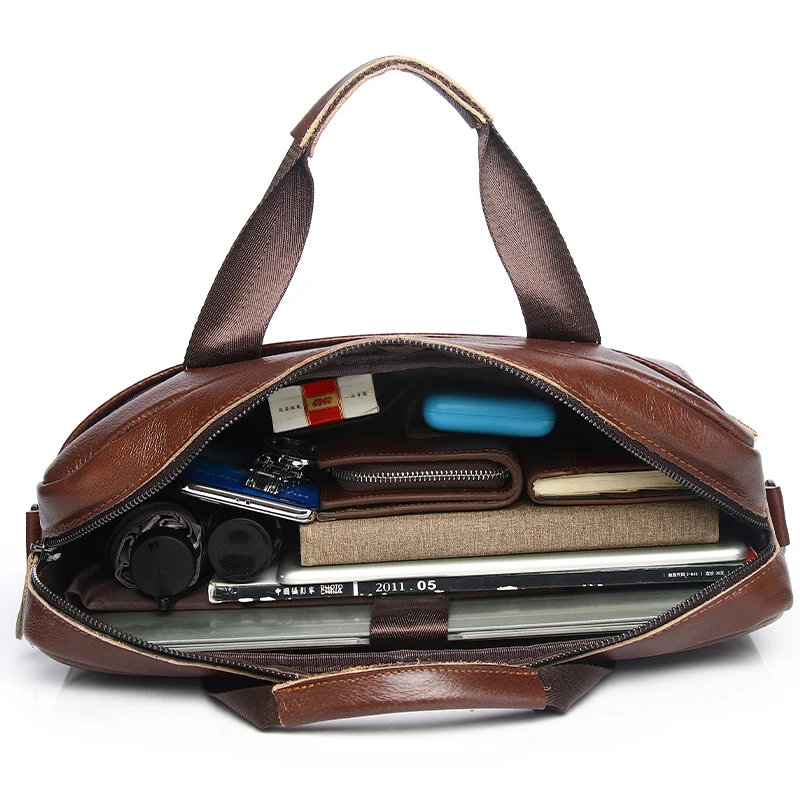
Closure and Security Considerations
The closure system impacts both security and convenience:
- Zip closures: Offer complete security but may restrict quick access
- Flap designs: Provide faster access but potentially less weather protection
- Combination approaches: Many premium briefcases feature zippered security compartments and quick-access pockets
- Lock mechanisms: Range from decorative to functional security features
The ideal organization system varies by profession and personal habits. Legal professionals might prioritize expanded document capacity, while technology professionals may need superior electronic organization. Consider your specific workflow when evaluating organized leather briefcases for work and explore our classic laptop briefcase collection for technology-optimized designs.
Aesthetic Considerations: Color, Texture, and Personalization
While functionality forms the foundation of your briefcase selection, aesthetic elements communicate your professional identity and personal style. These visual and tactile characteristics influence both first impressions and long-term satisfaction.
Color Selection and Professional Implications
Your briefcase color should harmonize with your professional environment and personal wardrobe:
Classic Black: The most formal and traditional option, black leather conveys authority and professionalism. Ideal for conservative fields like banking, law, and corporate leadership, black briefcases complement formal business attire and remain impervious to fashion trends. However, they show scratches and wear more visibly than lighter colors.
Rich Brown Tones: From chocolate to cognac, brown briefcases offer sophisticated versatility. Slightly less formal than black but entirely professional, brown tones complement a broader wardrobe palette. Brown leather also develops character more visibly as it ages, with natural patina highlighting the quality of the leather.
Tan and Cognac: These lighter brown variations project a more contemporary, approachable professionalism. Particularly well-suited to creative industries and business-casual environments, these colors develop the most dramatic and appealing patina over time, showcasing the leather’s quality.
Navy and Burgundy: These alternatives remain professional while offering subtle distinction. These colors can complement personal style while maintaining decorum in traditional environments.
Texture Considerations
Texture affects both appearance and durability:
– Smooth leather projects polished formality but may show scratches more readily
– Lightly pebbled textures balance refinement with practical scratch resistance
– Heavily textured leathers provide distinctive character and exceptional durability
The Appeal of Patina Development
Quality leather’s ability to develop patina—a natural luster and color deepening that occurs through use and exposure—represents one of its most distinctive attributes. This evolution:
– Creates a unique finish impossible to artificially replicate
– Enhances character and visual appeal over time
– Reflects the briefcase’s journey alongside your career
– Serves as a visible indicator of leather quality
Personalization Options
Subtle personalization can enhance both function and personal connection:
– Monogramming of initials in discreet locations
– Custom hardware selections offered by premium manufacturers
– Interior color or material customization
– Personalized compartment configurations
The right aesthetic choices create a briefcase that feels personally and professionally aligned. For more guidance on color selection, our resources on black and brown leather briefcases for men provide detailed perspectives, while our collection of black leather briefcases offers timeless professional options.
Investment Considerations: Budget, Value, and Purchasing Guidance
A quality leather briefcase represents a significant financial commitment. Understanding the relationship between price points, quality expectations, and long-term value helps ensure satisfaction with your investment.
Price Range Framework
| Price Category | Typical Price Range | Expected Quality Features | Optimal For |
|---|---|---|---|
| Entry-Level | $150-$300 | Good-quality leather, basic construction, limited warranty | Beginning professionals, infrequent use |
| Mid-Range | $300-$700 | Full/top-grain leather, quality hardware, solid construction, comprehensive warranty | Daily professional use, career advancement |
| Premium | $700-$1,500 | Finest full-grain leather, premium hardware, exceptional craftsmanship, lifetime guarantee | Professional establishment, signature accessory |
| Luxury | $1,500+ | Prestigious brand heritage, exotic leathers, artisanal craftsmanship, personalization options | Executive positioning, status signaling |
Factors Influencing Price
Multiple elements contribute to a briefcase’s cost structure:
– Leather quality: Full-grain leather costs significantly more than processed alternatives
– Construction methods: Hand-stitching and traditional techniques increase labor costs
– Hardware quality: Premium metals and proprietary components add substantial cost
– Brand positioning: Heritage brands command price premiums based on reputation
– Origin: Production location significantly impacts labor costs and techniques
– Design complexity: Multi-compartment designs with specialized features increase production costs
The Cost-Per-Use Principle
When evaluating investment value, consider the expected lifespan divided by purchase price:
A $700 briefcase used daily (250 workdays/year) for 10 years equals:
– 2,500 total days of use
– $0.28 cost per day of professional service
– Significant residual value if well-maintained
Contrast this with lower-quality alternatives requiring replacement every 2-3 years, and the economics often favor higher initial investment for quality construction.
Where to Purchase
The retail source significantly impacts both price and quality assurance:
- Specialty leather goods retailers: Offer expertise, curated selection, and personalized guidance
- Direct-from-artisan: Provides unique designs and potential customization but requires confidence in maker
- Department stores: Convenient but typically focused on fashion brands rather than heritage craftsmanship
- Online specialists: Offer broader selection but require careful research of return policies and authenticity
Pre-Purchase Questions
Before finalizing your investment, ask these critical questions:
– What specific grade of leather is used throughout the entire bag?
– Are the handles and stress points reinforced? How?
– What warranty is provided and what specifically does it cover?
– What care recommendations and support are offered?
– What is the return policy if the briefcase doesn’t meet expectations?
Men's Classic Leather Briefcase, Slim Leather Laptop Briefcase, Slim Leather Portfolio Briefcase
$93.67 Select options This product has multiple variants. The options may be chosen on the product pageClassic Laptop Briefcase, Men's Classic Leather Briefcase, Slim Leather Attache Case
Price range: $353.50 through $360.81 Select options This product has multiple variants. The options may be chosen on the product pageBlack Leather Briefcase, Leather Document Bag, Men's Classic Leather Briefcase
Genuine Crocodile Leather Executive Briefcase with Password Lock – Premium Business Document Carrier$1,201.87 Select options This product has multiple variants. The options may be chosen on the product pageBlack Leather Briefcase, Classic Laptop Briefcase, Men's Classic Leather Briefcase, Slim Leather Laptop Briefcase
$228.72 Select options This product has multiple variants. The options may be chosen on the product pageBrown Leather Briefcase, Classic Laptop Briefcase, Crazy Horse Leather Satchel, Men's Classic Leather Briefcase
Price range: $172.15 through $200.02 Select options This product has multiple variants. The options may be chosen on the product pageMen's Slim Leather Briefcase, Slim Leather Laptop Briefcase, Vegan Leather Briefcase
Price range: $120.82 through $131.11 Select options This product has multiple variants. The options may be chosen on the product page
Understanding these investment considerations helps balance budget constraints with quality requirements. For those seeking quality without excessive cost, our guide to affordable quality leather briefcases provides valuable perspectives, while our collection of leather document bags offers practical alternatives at various investment levels.
Care and Maintenance: Preserving Your Investment
A quality leather briefcase can serve you for decades, but this longevity depends significantly on proper care routines. Establishing simple maintenance habits protects your investment and enhances the natural beauty of the leather as it ages.
Essential Leather Care Routine
Regular Cleaning (Weekly)
1. Empty all contents completely
2. Wipe exterior with a clean, slightly damp cloth to remove surface dust
3. Use a soft brush to clean seams and crevices where dust accumulates
4. Allow to fully air dry away from direct heat sources
5. Clean interior with a lint roller or vacuum attachment
Conditioning (Every 3-6 Months)
1. Test leather conditioner on an inconspicuous area first
2. Apply small amount of quality leather conditioner with a soft cloth
3. Work in small circular motions covering all leather surfaces
4. Pay special attention to areas with high friction and bending
5. Allow to fully absorb (typically 12-24 hours)
6. Buff gently with a clean cloth to remove excess
Stain Management and Prevention
Immediate Spill Response:
– Blot (never rub) liquids immediately with an absorbent cloth
– Allow to air dry naturally away from direct heat
– For water spots, dampen the entire affected panel evenly for uniform drying
– Address oil-based stains with a small amount of leather-specific cleaner
Preventative Measures:
– Apply leather protector appropriate for your specific leather type
– Keep pens capped and potential leaking items contained
– Consider using a briefcase liner during inclement weather
– Avoid prolonged exposure to direct sunlight
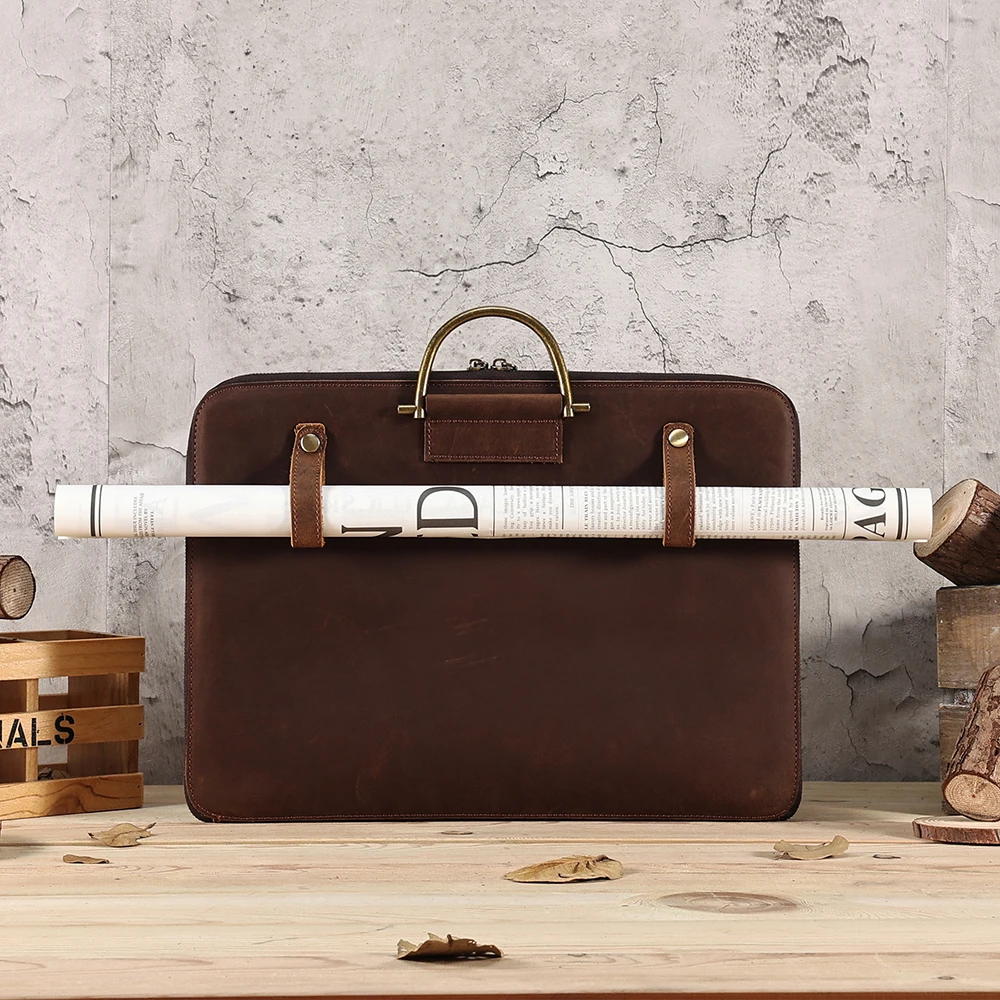
Proper Storage
When not in use, proper storage preserves both material and structure:
- Store in a cotton dust bag or pillowcase (never plastic)
- Maintain shape with light stuffing (acid-free tissue paper works well)
- Position upright rather than stacking beneath other items
- Keep in climate-controlled environment away from extreme temperatures
- Avoid prolonged storage in damp conditions
Hardware Maintenance
Don’t overlook the metal components:
– Periodically check and tighten any loose hardware
– Clean metal elements with appropriate polish for specific metal type
– Apply small amount of machine oil to zippers that begin to catch
– Address squeaking hinges promptly with appropriate lubricant
Professional Care Considerations
Know when to seek professional assistance:
– Significant structural damage to seams or handles
– Deep scratches or gouges that penetrate the surface
– Color restoration for faded or damaged areas
– Replacement of damaged hardware or failed zippers
– Comprehensive restoration of vintage pieces
Implementing these care practices maintains both functionality and aesthetics. For detailed guidance specific to briefcases, our resource on how to maintain a leather briefcase provides comprehensive care instructions, while our collection of brown leather briefcases showcases how proper care enhances patina development over time.
Pre-Purchase Evaluation: Ensuring the Right Selection
After understanding all key considerations, this final evaluation framework helps confirm you’re making the right selection for your specific needs and preferences. This methodical approach prevents expensive mistakes and ensures lasting satisfaction.
Comprehensive Pre-Purchase Checklist
Quality Fundamentals:
– Verified leather grade (full-grain or top-grain preferred)
– Consistent, reinforced stitching at all stress points
– Quality hardware with smooth operation
– Proper edge finishing and burnishing
– Balanced weight distribution when empty
Practical Functionality:
– Accommodates all essential carry items comfortably
– Interior organization matches your specific needs
– Weight feels manageable when fully loaded
– Comfortable to carry for extended periods
– Closure system provides appropriate security with convenient access
Professional Alignment:
– Style and formality match your work environment
– Color complements your typical wardrobe
– Design reflects appropriate professional image
– Features address industry-specific requirements
– Projects desired impression to clients and colleagues
Investment Protection:
– Clear warranty terms covering manufacturing defects
– Available repair services if needed
– Care instructions and recommended products
– Reputable retailer with fair return policy
– Established brand or artisan with history of quality
Physical Evaluation Techniques
Whenever possible, evaluate the briefcase in person:
– Test all zippers, buckles, and closure systems multiple times
– Fully open and close the bag to assess ease of access
– Verify comfort of handles and straps when loaded
– Examine interior in good lighting to assess organization
– Check all corners and stress points for reinforcement
Making the Final Decision
When you’ve narrowed your options, consider these final decision-making factors:
– Which option best balances your unique priorities?
– Which would serve you well across the broadest range of professional situations?
– Which design creates the strongest emotional connection?
– Which offers the strongest value proposition across your expected years of use?
– Which would you proudly carry ten years from now?
This structured evaluation process helps navigate the many considerations involved in selecting your ideal leather briefcase. For additional guidance on this final selection process, our comprehensive resource on how to choose the perfect leather briefcase provides detailed decision frameworks.
Is a Premium Leather Briefcase Worth the Investment?
This question ultimately depends on your professional context, personal priorities, and financial situation. However, several factors make quality leather briefcases a justifiable investment for many professionals.
When considering return on investment, quality leather briefcases offer exceptional longevity compared to alternatives. A well-crafted briefcase can serve your professional needs for 10-20 years, whereas synthetic or lower-quality options typically require replacement every 2-3 years. This extended lifespan significantly reduces the actual cost-per-use over time.
Beyond mere practicality, premium briefcases provide intangible professional benefits. Research consistently shows that appropriate professional accessories influence perception in business settings. Your briefcase makes a statement about your attention to detail, quality standards, and professional self-concept before you speak a single word in meetings.
For professionals in client-facing roles or those regularly participating in high-stakes presentations and negotiations, this non-verbal communication element can meaningfully influence outcomes. While difficult to quantify, many successful professionals consider these impression management aspects well worth the investment.
That said, quality leather briefcases aren’t universally necessary. Those in extremely casual work environments, professionals who rarely transport documents or technology, or those in early career stages with significant financial constraints may reasonably prioritize other investments. The men’s classic leather briefcase collection offers premium options when you’re ready to make this investment.
Innovative Features in Modern Leather Briefcases
While traditional craftsmanship remains the foundation of quality leather briefcases, modern innovations have enhanced functionality without compromising classic aesthetics. Today’s premium briefcases often integrate contemporary features that address the needs of modern professionals.
Technology integration has become increasingly sophisticated, with features like:
– Built-in USB charging ports connected to power bank compartments
– RFID-blocking pockets protecting electronic credentials
– Cable management systems preventing tangles
– TSA-compliant laptop compartments for frequent travelers
– Shock-absorbing padding designed specifically for electronic devices
Material innovations complement traditional leather, including:
– Ballistic nylon reinforcement in high-wear interior areas
– Antimicrobial linings for frequently touched surfaces
– Water-resistant treatments that preserve breathability
– Lightweight internal frames providing structure without weight
– Memory foam padded handles and straps for carrying comfort
These innovations maintain classic appearance while addressing contemporary needs, making leather briefcases more relevant than ever in modern professional environments. Our collection of top-rated classic leather briefcases showcases how traditional design can integrate modern functionality without sacrificing timeless appeal.

